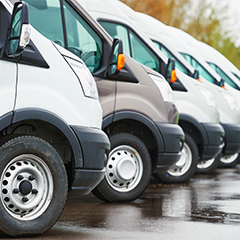Keep Your Fleet Safe and Save Money
October 14, 2016 | Deductions, Financial Planning, Tax Planning, Tax Preparation
 Whether your Maine company has one vehicle on the road or dozens of vehicles, smart management can save you money. Familiarity with tax laws, simple maintenance steps and high-tech solutions can reduce the costs of operating your fleet and keep it safer.
Whether your Maine company has one vehicle on the road or dozens of vehicles, smart management can save you money. Familiarity with tax laws, simple maintenance steps and high-tech solutions can reduce the costs of operating your fleet and keep it safer.
Start With Taxes
Spending time with a financial professional is one of the best ways to save money. Deductions can make a major difference in the cost of operating company vehicles, particularly in the first year of ownership. For example, under current tax law:
- You can deduct the business-use percentage of such operating costs as gasoline, oil, maintenance and insurance.
- You can deduct certain amounts for depreciation of vehicles used for business purposes, including passenger cars and light trucks or vans.
- If you lease, you can deduct the business-use percentage of your monthly payments. Deductions are slightly reduced for certain passenger cars and light trucks and vans. You can also write off the business-use percentage of operating costs for a leased vehicle.
Keep good records of the business miles you drive for tax purposes, whether you buy or lease.
Follow Up With Maintenance
Consider savings beyond tax savings. Simple maintenance can keep your costs down and your safety record up. Here are a few tips:
- Alignment. Inspect tires every 30 days for wear and evidence that the suspension isn’t aligned properly. Maine winters can be rough!
- Gasoline. Don’t use premium gasoline unless necessary. If your vehicles don’t specifically require an upgraded fuel, buy regular unleaded.
- Load Weight. Make sure your vehicles don’t carry more than which they were designed.
- Pressure. Check the air pressure of your tires daily when they are cold and fill if necessary. Low air pressure causes stress and irregular wear that can result in loss of control.
- Rotation. Regular rotation of your vehicle’s tires will help achieve more uniform wear. The guideline for tire rotation is approximately every 6,000 miles.
- Maintenance. Shop around when you hire out routine maintenance. Costs can vary as much as 50 percent depending on which shop you use. Consider doing in-house maintenance. Your business can be more productive if your vehicles continue to run during normal hours and are serviced by staff mechanics after hours.
- Protection. Keep your fleet in a garage or parked under a carport. It helps keep them in better condition and if garaged, may lower your insurance cost.
- Shop for insurance. Re-bid your insurance policy to make sure you’re getting the best deal.
- Encourage safety. Run a motor vehicle report on every driver in the company. Revoke driving privileges for those with multiple infractions. Consider rewarding those with good records.
Watch for Hidden Costs
There are a handful of subtle, easily overlooked costs. Getting caught in traffic jams, or even getting lost, can waste substantial gas and time for those who spend many hours on the road. When you buy new cars, consider a Global Positioning System. It can be worth the monthly service charge. These systems, such as OnStar, are built into a number of new model vehicles.
Many services have sprung up that can be helpful, even if your cars don’t have GPS. There are even tracking devices that allow complete surveillance for employers that really want to keep a close eye on their staff members in company cars and trucks. These services also assist in finding stolen vehicles. For example, some systems track by satellite, letting you know exactly where vehicles are.
And some systems even check speed. If a vehicle exceeds a pre-set limit, the system automatically honks the horn and flashes the parking lights, to signal the driver to slow down. If you want the driver to stay put, you can disable the starter. You can also track the vehicle from the Internet and set a perimeter of up to 30 miles. If the perimeter is broken, the company calls, e-mails or texts to alert you. The unit also notifies vehicle owners if the car has been in a collision.
Consider the Savings
Having a company vehicle program in place that combines taxes, safety and efficiency, and maintenance, can reduce liability and produce savings for your business.
